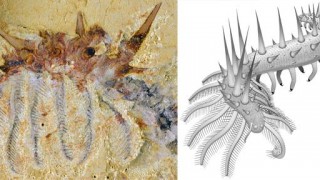
Researchers recently stumbled across the fossils of a spiky, superarmored worm, called Hairy Collins’ Monster. Unearthed in the Xiaoshiba deposit of South China, the 500 million-year-old worm was investigated by paleontologists from Yunnan University, China, and the University of Cambridge, England.
According to the research team, the fossilized remains represents one of the first creatures to have developed armored protection. Hairy Collins’ Monster (Collinsium ciliosum) was also capable of using its feather-like front legs to siphon nutrients out of seawater - a novel feeding technique that was new to the time.
The so-called “Monster” was named after Desmond Collins, who first illustrated the bizarre creature in 1980. The species lived during a period of accelerated evolutionary development, famously known as the Cambrian explosion. After performing a detailed investigation of the fossil remains, the researchers discovered that the Hairy Collins’ Monster is an early ancestor of today’s velvet worms (onychophorans). Possessing a centipede-like appearance, slime glands and tiny eyes, the Onychophora primarily inhabit tropical forests of the Southern Hemisphere.
According to lead author Dr. Javier Ortega-Hernández, of Cambridge University’s Department of Earth Sciences, modern velvet worms feature a similar “general body organisation” to that of the Hairy Collins’ Monster. “But during the Cambrian, the distant relatives of velvet worms were stunningly diverse and came in a surprising variety of bizarre shapes and sizes,” explained Ortega-Hernández.
Ortega-Hernández’s team were able to use the specimen from southern China to gain some insight into the Monster’s digestive tract and full body organization. As with the velvet worm, Hairy Collins’ Monster boasted a squishy body and multiple legs - nine pairs of rear legs and six pairs of front legs. The rear legs ended in claw-like projections that could fasten onto different surfaces, while the “feather-like” forearms were deployed to harvest nutrients from the environment.
To protect its soft, fragile body, Collins’ Monster had 72 spikes jutting from its body. According to the researchers, the creature has a similar protective layout to another Cambrian creature, called the Hallucigenia. Ortega-Hernández said Hairy Collins’ Monster was “… like Hallucigenia on steroids.” He then went on to explain that the two species, along with four others, were part of the Luolishaniidae family, with the team’s latest discovery helping to improve the scientific community’s understanding of the peculiar-looking organisms.
The study, entitled A superarmored Lobopodian from the Cambrian of China and early disparity in the evolution of Onychophora, was published in the journal Proceedings of the National Academy of Sciences.
Top image credit: Jie Yang, Javier Ortega-Hernández.
